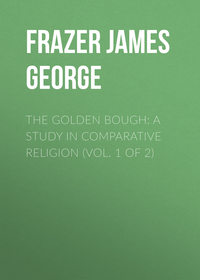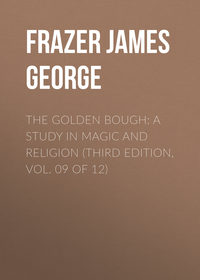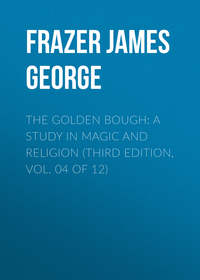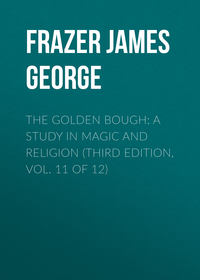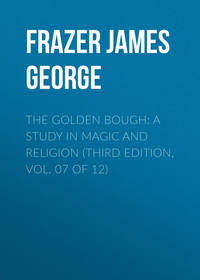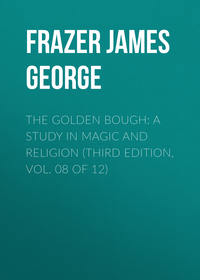
The Belief in Immortality and the Worship of the Dead, Volume 2 (of 3)
291
Capt. James Cook, Voyages, i. 157 sq., "Their name for such burying-grounds, which are also places of worship, is Morai." Compare id., i. 217, 219, 220, 224, vi. 37, 41; J. Turnbull, Voyage round the World (London, 1813), p. 151, "the morais, which serve the double purpose of places of worship and receptacles for the dead." Compare J. R. Forster, Observations, p. 545, "To ornament the marais and to honour by it the gods and the decayed buried there, the inhabitants plant several sorts of trees near them."
292
D. Tyerman and G. Bennet, op. cit. i. 271.
293
W. Ellis, Polynesian Researches, i. 405. Elsewhere (p. 401), speaking of the Tahitian burial customs, Ellis observes that "the skull was carefully kept in the family, while the other bones, etc., were buried within the precincts of the family temple."
294
J. A. Moerenhout, op. cit. i. 470. As to the Tahitian custom of burying the dead in the marais, see also C. E. Meinicke, Die Inseln des Stillen Oceans, ii. 183 sq., according to whom only the bodies of persons of high rank were interred in these sanctuaries.
295
G. H. von Langsdorff, op. cit. i. 115.
296
G. H. von Langsdorff, op. cit. i. 134.
297
Vincendon-Dumoulin et C. Desgraz, Îles Marquises ou Nouka-hiva (Paris, 1843), p. 253.
298
C. E. Meinicke, Die Inseln des Stillen Oceans, ii. 180.
299
W. H. R. Rivers, "Sun-cult and Megaliths in Oceania," American Anthropologist, N.S. xvii. (1915) pp. 431 sqq.
300
W. Mariner, Tonga Islands, i. 88.
301
Above, pp. 74 sqq.
302
W. Mariner, Tonga Islands, i. 88 sq.
303
Sarah S. Farmer, Tonga and the Friendly Islands, p. 127.
304
W. Mariner, op. cit. i. 367.
305
W. Mariner, Tonga Islands, ii. 196-202, compare p. 78. The ceremony was also witnessed, though not understood, by Captain Cook (Voyages, v. 363 sqq.) and by the first English missionaries (Captain James Wilson, Missionary Voyage to the Southern Pacific Ocean, pp. 264 sq.).
306
See the letter of Dr. Charles Forbes, in Archaeologia, or Miscellaneous Tracts relating to Antiquity, xxxv. (London, 1853) p. 496 (with a woodcut); Proceedings of the Society of Antiquaries of London [First Series], iii. 19; id. Second Series, i. 287; letter of Philip Hervey, quoted by Kenneth R. H. Mackenzie, in Proceedings of the Society of Antiquaries of London, Second Series, ii. 75-77; Julius L. Brenchley, Jottings during the Cruise of H.M.S. "Curaçoa" among the South Sea Islands in 1865 (London, 1873), p. 132 (with a woodcut); (Sir) Basil Thomson, Diversions of a Prime Minister (Edinburgh and London, 1894), pp. 380-382 (with a woodcut on p. 393); id. "Notes upon the Antiquities of Tonga," Journal of the Anthropological Institute, xxxii. (1902) pp. 81-84 (with a photograph). Views of the monument, taken apparently from photographs, have also been published by Dr. F. H. H. Guillemard (Australasia, vol. ii. London, 1894, p. 501), Dr. George Brown (Melanesians and Polynesians, London, 1910, plate facing p. 410), and by Mr. S. Percy Smith (Hawaiki, Third Edition, Christchurch, N.Z., 1910, pp. 157 sq.). Dr. W. H. R. Rivers spoke as if there were several trilithons in Tongataboo (History of Melanesian Society, ii. 430 sq.; id. "Sun-cult and Megaliths in Oceania," American Anthropologist, N.S. xvii., 1915, p. 444); but in this he seems to have been mistaken. So far as I can gather, there is only one of these remarkable monuments in Tongataboo or indeed in the whole of the Pacific.
307
For the authorities, see the preceding note. The measurements, to some extent discrepant, are given by Dr. Charles Forbes, Mr. Philip Hervey, and the passengers of s.s. Wairarapa, as reported by Sir Basil Thomson Journal of the Anthropological Institute, xxxii. 82 sq.), who had unfortunately mislaid his own notes containing the measurements. The statement that the monument was surmounted by a large bowl is made by Mr. Brenchley, in whose sketch of the structure the bowl figures. But Mr. Brenchley did not himself see the monument, and nobody else appears to have seen the bowl. I suspect that the report of the bowl may have originated in a hasty reading of Mr. Hervey's statement that "on the centre of it [the cross-stone] a small cava bowl is scooped out," though in Mr. Brenchley's account the bowl has seemingly increased in size. Similarly in his report the height of the uprights has grown to about thirty feet, which appears to be just double of their real size. Perhaps Mr. Brenchley's erroneous allegation as to the material of the monument similarly originated in a misunderstanding of Mr. Hervey's statement that "the material is the coral rock, or coral rag which are formed of stone brought from Wallis's Island."
308
Charles Forbes, in Archaeologia, xxxv. 496 (who gives Ho ha Mo-nga Maui as the name of the stones); (Sir) Basil Thomson, Diversions of a Prime Minister, p. 382; id., "Notes upon the Antiquities of Tonga," Journal of the Anthropological Institute, xxxii. (1902) p. 81 (who gives Haamonga as the native name of the stones).
309
(Sir) Basil Thomson, "Notes upon the Antiquities of Tonga," Journal of the Anthropological Institute, xxxii. (1902) p. 81. Maui is the great hero of Polynesia, known in nearly every group of islands, generally regarded as a demigod or deified man, but sometimes and in some places rising to the dignity of full godhead. He appears, says Mr. E. Tregear, to unite the classical attributes of Hercules and Prometheus. See E. Tregear, Maori-Polynesian Comparative Dictionary, p. 233, s. v. "Maui."
310
"Tui-ta-tui, lit. 'King-strike-King.'"
311
(Sir) Basil Thomson, "Notes upon the Antiquities of Tonga," Journal of the Anthropological Institute, xxxii. (1902) p. 82.
312
Proceedings of the Society of Antiquaries of London, Second Series, ii. 77.
313
Julius L. Brenchley, Jottings during the Cruise of H.M.S. "Curaçoa" among the South Sea Islands in 1865 (London, 1873), p. 132.
314
(Sir) Basil Thomson, Diversions of a Prime Minister, p. 395. In this work the author prints a list of the Tooitongas "as given by Mr. E. Tregear on the authority of the Rev. J. E. Moulton."
315
(Sir) Basil Thomson, "Notes upon the Antiquities of Tonga," Journal of the Anthropological Institute, xxxii. (1902) p. 83; S. Percy Smith, Hawaiki, p. 158.
316
W. Mariner, Tonga Islands, ii. 266. As to the size of the stones, Mariner says, "The stones used for this purpose are about a foot in thickness, and are cut of the requisite dimensions, out of the stratum found on the beaches of some of the islands."
317
(Sir) Basil Thomson, "Notes upon the Antiquities of Tonga," Journal of the Anthropological Institute, xxxii. (1902) pp. 83 sq.
318
W. H. R. Rivers, History of Melanesian Society, ii. 431.
319
See below, p. 212.
320
"Tangata, in their language, is man; Arekee, king."
321
Captain James Cook, Voyages, v. 298 sq. To this description of the monument Sir Basil Thomson has called attention; he rightly classes it with the tombs of the chiefs. See his "Notes upon the Antiquities of Tonga," Journal of the Anthropological Institute, xxxii. (1902) p. 85.
322
(Sir) Basil Thomson, "Notes upon the Antiquities of Tonga," Journal of the Anthropological Institute, xxxii. (1902) pp. 81 sq.
323
Dr. Charles Forbes, in Archaeologia, xxxv. p. 496.
324
I have no measurements of these intervals, but write from the impression of a recent visit to Stonehenge.
325
(Sir) Basil Thomson, "Notes upon the Antiquities of Tonga," Journal of the Anthropological Institute, xxxii. (1902) p. 82, quoting the anonymous pamphlet The Wairarapa Wilderness.
326
Lord Avebury, Prehistoric Times, Seventh Edition (London, 1913), pp. 132 sqq.; Sir Norman Lockyer, Stonehenge and other British Stone Monuments astronomically considered (London, 1906); C. Schuchhardt, "Stonehenge," Zeitschrift für Ethnologie, xlii. (1910), pp. 963-968; id. in Zeitschrift für Ethnologie, xliii. (1911) pp. 169-171; id., in Sitzungsberichte der königl. preuss. Akademie der Wissenschaften, 1913, pp. 759 sqq. (for the sepulchral interpretation); W. Pastor, "Stonehenge," Zeitschrift für Ethnologie, xliii. (1911) pp. 163- (for the solar interpretation).
327
Adolph Bastian observed that "sun-worship, which people used to go sniffing about to discover everywhere, is found on the contrary only in very exceptional regions or on lofty table-lands of equatorial latitude." See his book, Die Voelker des Oestlichen Asien, iv. (Jena, 1868) p. 175. Nobody, probably, has ever been better qualified than Bastian to pronounce an opinion on such a subject; for his knowledge of the varieties of human thought and religion, acquired both by reading and travel, was immense. It is only to be regretted that through haste or negligence he too often gave out the fruits of his learning in a form which rendered it difficult to sift and almost impossible to digest them. Yet from his storehouse he brought forth a treasure, of which we may say what Macaulay said of the scholarship of Parr, that it was "too often buried in the earth, too often paraded with injudicious and inelegant ostentation, but still precious, massive, and splendid."
328
F. H. H. Guillemard, Australasia, ii. 500.
329
W. Mariner, Tonga Islands, i. 266.
330
Captain James Cook, Voyages, v. 421.
331
Captain James Cook, Voyages, v. 345 sq. As to the mourning costume of mats and leaves, see also Captain James Wilson, Missionary Voyage to the Southern Pacific Ocean, p. 240; W. Mariner, Tonga Islands, i. 380, 392, 431, ii. 214 sq.
332
Captain James Cook, Voyages v. 420.
333
Jérôme Grange, in Annales de la Propagation de la Foi, xvii. (1845) p. 13.
334
Captain James Wilson, Missionary Voyage to the Southern Pacific Ocean, pp. 242-244.
335
Mariner defines a malai as "a piece of ground, generally before a large house, or chief's grave, where public ceremonies are principally held" (Tonga Islands, vol. ii., "Vocabulary" s. v.). It is the same word as malae or marae, noticed above, p. 116, note3.
336
W. Mariner, Tonga Islands, i. 379-384.
337
W. Mariner, op. cit. i. 440-442.
338
W. Mariner, Tonga Islands, i. 404 sq.
339
W. Mariner, op. cit. i. 144 note *.
340
See above, p. 105.
341
W. Mariner, op. cit. i. 388 note *.
342
W. Mariner, op. cit. i. 388 sq.
343
W. Mariner, op. cit. i. 389-392.
344
W. Mariner, op. cit. i. 392 sq.
345
W. Mariner, op. cit. i. 393.
346
W. Mariner, op. cit. i. 141 note *.
347
Captain James Cook, Voyages, v. 336. The writer does not translate the expression taboo mattee; but mate is the regular Tongan word for "death" or "to die." See Mariner, Tonga Islands, Vocabulary, s. v. "Mate." Compare E. Tregear, Maori-Polynesian Comparative Dictionary, p. 228, s. v. "Mate."
348
W. Mariner, Tonga Islands, i. 394 sq.
349
W. Mariner, op. cit. i. 401-403.
350
Above, pp. 135 sq.
351
W. Mariner, Tonga Islands, i. 403-405.
352
Captain James Wilson, Missionary Voyage to the Southern Pacific Ocean, p. 265.
353
The Golden Bough, Part III., The Dying God, pp. 92 sqq.
354
W. Mariner, Tonga Islands, ii. 213 sq.
355
Captain James Wilson, Missionary Voyage to the Southern Pacific Ocean, p. 243.
356
W. Mariner, op. cit. ii. 214 sq.
357
W. Mariner, Tonga Islands, ii. 213.
358
W. Mariner, Tonga Islands, ii. 215-217.
359
W. E. Roth, Ethnological Studies among the North-west-central Queensland Aborigines (Brisbane and London, 1897), pp. 117 sq.; (Sir) Baldwin Spencer and F. J. Gillen, Northern Tribes of Central Australia (London, 1904), pp. 234, 235; id., Native Tribes of Central Australia (London, 1899), p. 281 note; id., Across Australia (London, 1912), i. 244.
360
W. Mariner, Tonga Islands, ii. 217-219.
361
W. Mariner, Tonga Islands, ii. 220.
362
W. Mariner, Tonga Islands, i. 112 sq., 120-126, ii. 220.
363
W. Mariner, op. cit. ii. 135, 209 sq., 214.
364
Captain James Wilson, Missionary Voyage to the Southern Pacific Ocean, p. 240.
365
This was the reason assigned for the strangling of widows at their husband's funeral in Fiji. See John Williams, Narrative of Missionary Enterprises in the South Sea Islands, pp. 478 sq.
366
E. Renan, Histoire du peuple d'Israël, ii. 505.
367
Ch. Wilkes, Narrative of the United States Exploring Expedition, New Edition (New York, 1851), ii. 117; J. B. Stair, Old Samoa (London, 1897), pp. 21 sq.; F. H. H. Guillemard, Australasia, ii. (London, 1894) p. 500; G. Brown, Melanesians and Polynesians (London, 1910), pp. 1, 360.
368
J. B. Stair, Old Samoa, pp. 27 sq.; F. H. H. Guillemard, op. cit. pp. 500, 504.
369
J. E. Erskine, Journal of a Cruise among the Islands of the Western Pacific (London, 1853), p. 110; T. H. Hood, Notes of a Cruise in H.M.S. "Fawn" in the Western Pacific (Edinburgh, 1863), p. 40; J. L. Brenchley, Jottings during the Cruise of H.M.S. "Curaçoa" among the South Sea Islands in 1865 (London, 1873), pp. 37-39, 61 sq.; F. H. H. Guillemard, Australasia, ii. 502 sq.; John B. Stair, Old Samoa, pp. 26 sqq.
370
J. B. Stair, Old Samoa, pp. 31 sq., 52 sq.
371
Violette, "Notes d'un Missionnaire sur l'archipel de Samoa," Les Missions Catholiques, iii. (1870) pp. 71 sq.; F. H. H. Guillemard, Australasia, ii. 502 sq.; J. B. Stair, Old Samoa, p. 34; G. Brown, Melanesians and Polynesians, pp. 1 sqq.
372
F. H. H. Guillemard, op. cit. ii. 504; J. B. Stair, Old Samoa, p. 43.
373
G. Brown, Melanesians and Polynesians, p. 3.
374
J. B. Stair, Old Samoa, pp. 33 sq.; G. Brown, Melanesians and Polynesians, p. 171.
375
T. H. Hood, Notes of a Cruise in H.M.S. "Fawn" in the Western Pacific (Edinburgh, 1863), p. 145; J. B. Stair, op. cit. pp. 41 sq.
376
Ch. Wilkes, Narrative of the United States Exploring Expedition, ii. 118; Violette, "Notes d'un Missionnaire sur l'archipel de Samoa," Les Missions Catholiques, iii. (1870) p. 72 (who, however, affirms that the climate is not unhealthy); T. H. Hood, Notes of a Cruise in H.M.S. "Fawn" in the Western Pacific (Edinburgh, 1863), pp. 144 sq.; J. B. Stair, Old Samoa, pp. 16, 35 sqq.
377
Ch. Wilkes, Narrative of the United States Exploring Expedition, ii. 124 sq.; J. B. Stair, Old Samoa, pp. 165 sq., 169 sq.; G. Brown, Melanesians and Polynesians, pp. 180 sqq.
378
S. Ella, "Samoa," Report of the Fourth Meeting of the Australasian Association for the Advancement of Science, held at Hobart, Tasmania, in January 1892, p. 622.
379
Ch. Wilkes, Narrative of the United States Exploring Expedition, ii. 72; Violette, "Notes d'un Missionnaire sur l'archipel de Samoa," Les Missions Catholiques, iii. (1870) p. 72; F. H. H. Guillemard, Australasia, ii. 504; J. B. Stair, Old Samoa, pp. 38-41.
380
Horatio Hale, Ethnography and Philology of the United States Exploring Expedition (Philadelphia, 1846), pp. 119 sqq.; J. E. Erskine, Journal of a Cruise among the Islands of the Western Pacific, pp. 102 sq.; J. B. Stair, Old Samoa, pp. 271 sqq. (compare id. p. 34 as to the timber and canoe-building of Savaii); G. Brown, Melanesians and Polynesians, pp. 358, 371 sq.; A. C. Haddon, The Wanderings of Peoples (Cambridge, 1919), p. 36; A. H. Keane, Man Past and Present (Cambridge, 1920), p. 552. That the Samoan language, alone of the Polynesian dialects, retains the S sound, is affirmed by Ch. Wilkes (Narrative of the United States Exploring Expedition, ii. 123). In some of the islands the name of the ancient fatherland of the race (Hawaiki, etc.) has been applied or transferred to the spirit-land to which the souls of the dead are supposed to pass as their final abode. See S. Percy Smith, Hawaiki, pp. 46 sqq.; E. Tregear, Maori-Polynesian Comparative Dictionary, pp. 56 sqq., s. v. "Hawaiki."
381
G. Brown, Melanesians and Polynesians, pp. 360 sq. As to the Fijian colony in Savaii, compare T. H. Hood, Notes of a Cruise in H.M.S. "Fawn" in the Western Pacific (Edinburgh, 1863), pp. 117 sq.
382
S. Percy Smith, Hawaiki, pp. 114 sq.
383
Horatio Hale, Ethnography and Philology of the United States Exploring Expedition, pp. 10 sq.; Ch. Wilkes, Narrative of the United States Exploring Expedition, ii. 125 sq.; J. E. Erskine, Journal of a Cruise among the Islands of the Western Pacific, pp. 41, 51; C. E. Meinicke, Die Inseln des Stillen Oceans (Leipzig, 1875-1876), ii. 110 sq.; G. Turner, Samoa, p. 3; J. B. Stair, Old Samoa, p. 58; G. Brown, Melanesians and Polynesians, pp. 55 sq.
384
S. Ella, "Samoa," Report of the Fourth Meeting of the Australasian Association for the Advancement of Science, held at Hobart, Tasmania, in January 1892, p. 634.
385
T. H. Hood, Notes of a Cruise in H.M.S. "Fawn" in the Western Pacific (Edinburgh, 1863), pp. 59 sq.
386
J. E. Erskine, op. cit. p. 110
387
Ch. Wilkes, op. cit. ii. 125; J. E. Erskine, op. cit. p. 110
388
Ch. Wilkes, op. cit. ii. 148; Violette, " Notes d'un Missionnaire sur l'archipel de Samoa," Les Missions Catholiques, iii. (1870) p. 156; J. L. Brenchley, op. cit. p. 77; S. Ella, op. cit. pp. 628 sq.; G. Brown, op. cit. pp. 43, 410.
389
G. Brown, op. cit. p. 410.
390
For some evidence of the practice see John Turnbull, Voyage round the World (London, 1813), pp. 363 sq.; C. S. Stewart, Journal of a Residence in the Sandwich Islands (London, 1828), pp. 251 sqq.; P. Dillon, Voyage in the South Seas (London, 1829), ii. 134; William Ellis, Polynesian Researches, Second Edition (London, 1832-1836), i. 248 sqq.; J. Williams, Narrative of Missionary Enterprises in the South Sea Islands (London, 1838), pp. 479-486. According to Stewart, in those parts of Hawaii to which the influence of the missionaries had not penetrated, two-thirds of the infants born were murdered by their parents within the age of two years. In Tahiti three women, questioned by Mr. Williams, acknowledged that they had killed twenty-one of their children between them. Another, at the point of death, confessed to him, in an anguish of remorse, that she had destroyed sixteen of her children.
391
G. Turner, Samoa, p. 79. Compare J. Williams, op. cit. p. 479; S. Ella, op. cit. p. 621; G. Brown, Melanesians and Polynesians, p. 47.
392
G. Brown, Melanesians and Polynesians, p. 219.
393
G. Turner, Samoa, pp. 201 sq. Compare G. Brown, Melanesians and Polynesians, pp. 230 sq.; J. Williams, Narrative of Missionary Enterprises in the South Sea Islands, p. 471; J. B. Stair, Old Samoa, p. 210.
394
J. Williams, Narrative of Missionary Enterprises in the South Sea Islands, p. 456.
395
G. Turner, Samoa, pp. 108-111; G. Brown, Melanesians and Polynesians, pp. 149 sq., 290; J. E. Erskine, op. cit. pp. 39, 101 sq.; W. T. Pritchard, Polynesian Reminiscences (London, 1866), pp. 125 sq.; Violette, "Notes d'un Missionnaire sur l'archipel de Samoa," Les Missions Catholiques, iii. (1870) p. 168; J. B. Stair, Old Samoa, pp. 240 sq.
396
J. B. Stair, Old Samoa, pp. 91 sqq.; G. Brown, Melanesians and Polynesians, pp. 288-291. Compare Violette, "Notes d'un Missionnaire sur l'archipel de Samoa," Les Missions Catholiques, iii. (1870) pp. 119, 120.
397
S. Ella, "Samoa," Report of the Fourth Meeting of the Australasian Association for the Advancement of Science, held at Hobart, Tasmania, in January 1892, p. 633.
398
G. Brown, Melanesians and Polynesians, p. 245. Compare S. Ella, op. cit. p. 638.
399
See, for example, E. W. Smith and A. M. Dale, The Ila-speaking Peoples of Northern Rhodesia (London, 1920), i. 252 sqq.


